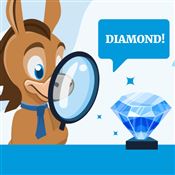How to Tell if a Diamond is Real
Unfortunately, a diamond is easily mimicked. But luckily, it's not too hard to weed out a fake. Try these simple tests to find out if your diamond is real.
 |
If you're concerned with the possibility of being duped with fake products and scams, education is your best weapon.
It only takes a few seconds of internet searching to educate yourself about the scam regarding the e-mail you just received from a Nigerian prince, for example.
You can also pay attention to the details to ensure you're purchasing a genuine product. Understand that if you're shown a watch in a dark alley that spells Rolex with a Q and a 6, chances are it's a fake.
Although some fakes may be easy to spot, others aren't so easy. You may feel like diamond engagement rings fit in the difficult-to-spot fake category. After all, most of us know little to nothing about diamonds. And we've all heard nightmarish stories of the glass ring that someone passed off as a diamond. One sparkly rock can look a lot like another at first glance.
Whether you're shopping for a diamond or you have some jewelry pieces handed down, it's smart to know what you've got.
You don't have to be a gemologist to perform these simple at-home tests. Read on to find out whether that sparkly rock is actually a diamond.
Browse Diamond Inspiration Gallery
What Makes a Diamond Fake?
People may try to sell you a fake diamond because of simple economics. Because real diamonds are so expensive, some people may try to pass off a stone that looks like a diamond as a real diamond. Fake diamonds will cost the seller quite a bit less than a real diamond, meaning the seller can make a larger profit by trying to pass off the fake diamond as real.
Now, this is not something a reputable jeweler would do.
But no matter where you're shopping, it's always smart to do some studying to make sure the diamond you're about to purchase is actually a diamond.
Simulants
 |
| © CreditDonkey |
Fake diamonds can be either man-made simulants or other natural gemstones. Here are the most common fake diamonds you may encounter.
- Cubic Zirconia: The most common type of fake diamond is the cubic zirconia. This is a synthetic stone that consists of zirconium dioxide.
For a novice, spotting the difference between a cubic zirconia stone and a real diamond can be a challenge. A cubic zirconia stone is hard, but it's still not as hard as a diamond. It can be scratched on the surface, causing it to dull over time, whereas a diamond holds its integrity over time.
- Glass: As you might suspect, glass is clear and has some sparkle to it, so it can look a bit like a diamond to the untrained eye. However, upon closer inspection, glass has nowhere near the toughness or brilliance of a real diamond.
- Moissanite: Although moissanite is a naturally occurring mineral, it's extremely rare. So all moissanite is now created in a lab (though it's still a real gemstone). Moissanite has a hardness and sparkle much like a diamond.
In fact, a moissanite stone almost sparkles more than a diamond. Because of the expense of moissanite, you won't often see it used as a substitute for diamonds in jewelry by someone trying to sell you a fake diamond.
- White Sapphire: The naturally occurring white sapphire stones are colorless. They're not as hard as diamonds, and often have a slight haziness. But sapphires are a precious gemstone, and they're an expensive enough stone that you likely won't see it substituted for a diamond by people trying to rip you off.
- White Topaz: To the casual observer, white topaz could look a lot like a diamond too. But it's a soft stone that can easily scratch and dull. White topaz is very cheap, costing just a tiny fraction of a diamond.
- Zircon: Zircon is a naturally occurring stone. This stone appears in many different colors, as well as colorless. Zircon is not quite as hard as cubic zirconia. If you want a cheaper alternative to a diamond, and you want a colored stone in your engagement ring, zircon is an option.
One of the best ways to check if a diamond is real is by taking it to a jeweler for an appraisal. The jeweler can use a number of tests to ensure the integrity of the stone.
No. Lab-created diamonds have the same physical and chemical properties as real diamonds. Just that the diamond is made in a lab instead of being mined from the earth. They are still real diamonds and many gemologists can't even tell the difference. Lab-grown diamonds are usually disclosed or laser inscribed as so. They can be up to 35% cheaper than a mined diamond.
Fakes Aren't Always Bad
It's worth noting that some people don't care if they have a fake diamond, as long as it looks great in an engagement ring or in another piece of jewelry.
Some people like the idea of being able to get an affordable, large fake diamond stone versus an expensive, small real diamond. Just make sure you know exactly what you're buying.
If you have a very limited budget for an engagement ring, you can consider buying a cubic zirconia stone for the engagement ring now. Later, when you can afford a real diamond, you can always replace the fake diamond stone.
Or, look into moissanite for a more durable alternative. Moissanite won't go cloudy over time like cubic zirconia. Plus, moissanite costs around 90% less than diamonds of the same size and quality. (You can click here to view moissanite rings on Brilliant Earth.)
Just be upfront with your fiancé before you do this. Trust us. Starting your married life by lying about the type of stone in the ring just sets you up for a lot of nights sleeping on the couch ... and that's the best-case scenario.
Testing a Diamond Already in a Setting
 |
| © CreditDonkey |
Now let's focus on some ways you can protect yourself by ensuring the diamond you're about to purchase is real.
If the diamond is already set in the ring, you're going to be a little bit limited as to how you can test the diamond. You still can look for some clues though.
- Fog It Up: Breathe directly onto the diamond. Because of the moisture in your exhaled breath, you should see a slight film or fog form on the diamond.
In a real diamond, that fog will dissipate right away. With the material used in a fake diamond, the fog will be visible for several seconds before fading away. If you keep breathing on it, a real diamond will always stay clear, while a fake one will get foggier.
- Ring: Closely inspect the ring. If it appears to be a poor quality ring or if it doesn't seem to consist of a common metal used in engagement rings - such as platinum, white gold, or yellow gold - you could have a fake diamond. Trustworthy jewelers just don't commonly place an expensive stone like a diamond in a lousy, cheap setting.
- Stamps: Inspect any stamps or markings on the inside of the ring. If you see 925 engraved on the ring, that means it's a sterling silver setting. Usually, engagement rings with a larger center diamond won't be set in sterling silver because it's too soft. And if you see a stamp that says "CZ," you're looking at a cubic zirconia stone, rather than a real diamond.
There are sterling silver rings with diamonds, but those likely will be tiny melee diamonds. Jewelers usually won't set a larger, more valuable center diamond in sterling silver.
If you see 10k, 14k, or 18k, that means gold. Platinum rings will usually have Plat or Pt marked on them. If the stone is set in gold or platinum, chances are that it's a precious gemstone.
- Setting and Mount: Look closely at the mount/setting area of the ring. The prongs should be tightly connected to the ring and should tightly wrap around the diamond, ensuring it will not pop loose. Again, a trusted jeweler isn't going to risk losing an expensive diamond by having it come loose from a poor quality mount. But if the stone is fake, there's not much reason to have it secured tightly inside the mount.
Testing a Loose Diamond
If you have a questionable loose stone, you can use a few different tests to see if your diamond is real or not.
- Heat test: Apply heat to the stone for 30-60 seconds, such as by using a lighter while holding the stone in metal pliers. Then drop the stone in a glass of cold water (making sure the glass has thick walls). A fake diamond made from glass or cubic zirconia will crack or shatter when exposed to a sudden temperature change.
On the other hand, a diamond does not react when placed under high heat or when subjected to extreme temperature changes. Don't worry, if it's real, it'll be completely fine. But only do this test if you don't care what happens to the stone if it's fake.
- The read-through test: A diamond will have a high level of refractivity (the ability to bend and scatter light, thus creating sparkle), especially compared to a fake diamond. Open a book, newspaper, or magazine to a page with plenty of printed text. Lay the diamond flat on the page. If you can read the text through the stone, it's almost certainly a fake diamond. A real diamond refracts light so strongly that you cannot see through it.
- Water test: Fill a tall glass of water nearly to the top. Take the loose diamond and set it in the water. If it floats (either on top of the water or just beneath the surface of the water), it's not a diamond. Diamonds have a density that is heavier than water, so they should settle at the bottom of the glass.
The jeweler will first look at the stone through a loupe - a special magnifying device. The jeweler will look for any flaws (called inclusions) within the stone. Most diamonds will have natural minerals, dark spots, and internal cracks. Of course, it is also possible to have a perfectly flawless diamond, but that is super rare (only 1% of all the world's diamonds). On the other hand, the man-made cubic zirconia is always flawless.
If you don't have the option of running a hands-on test, the best advice we can give to ensure you're receiving a real diamond is sticking with a reputable jeweler. Research the jeweler online. Make sure the diamond you're purchasing has an authentic GIA or AGS certificate. This is the best way to trust that you're buying the real thing. It's smart even to have a third party appraise the diamond immediately after you purchase it.
Finally, don't let the sparkle of the diamond make you forget to use common sense. If the price you're paying for a particular diamond seems far too good to be true, there may be a reason: Your "jeweler" may spell diamond with a Q and a 6.
Write to Kyle Schurman at feedback@creditdonkey.com. Follow us on Twitter and Facebook for our latest posts.
Note: This website is made possible through financial relationships with some of the products and services mentioned on this site. We may receive compensation if you shop through links in our content. You do not have to use our links, but you help support CreditDonkey if you do.
|
|
| ||||||
|
|
|














